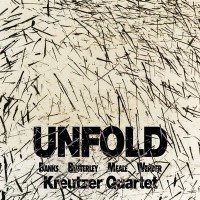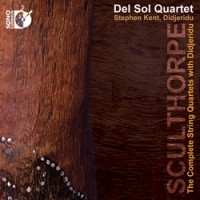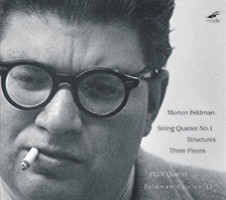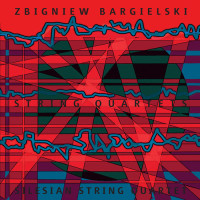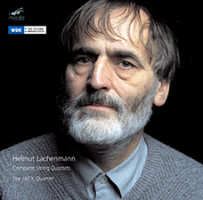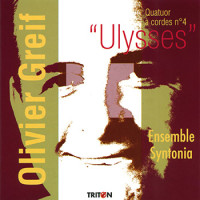String Theory 17: 21 String Quartets
|
Grant Chu Covell [February 2016.]
“Unfold.” Don BANKS: String Quartet (1975). Nigel BUTTERLEY: String Quartet (1965). Richard MEALE: String Quartet No. 1 (1974). Felix WERDER: String Quartett No. 8, “Consort Music” (1964). Kreutzer Quartet: Peter Sheppard Skærved, Mihailo Trandafilovski (vln), Morgan Goff (vla), Neil Heyde (vlc). Move Records MD 3371 (1 CD) (http://www.move.com.au/). The versatile Kreutzer Quartet takes a whirl in the time machine and journeys to Australia for four string quartets composed between 1964 and ‘75. Meale and Werder receive first performances. These Banks and Butterley quartets haven’t been committed to disc since the 1980s (ABC AC 1051 and ABC RRCS 126). What looks to be a historical outing actually sounds as fresh and compelling as anything written last week. Michael Hooper’s fine notes explain the endeavor. Banks’ 20-minute single-movement quartet reflects studies with Dallapiccola, Babbitt and Gerhard, a strongly expressive atonal sensibility that his Australian colleagues never fully appreciated. Butterley would write four quartets. These two movements take inspiration from a poem by Henry Vaughan (1621-1695), The Revival, whose first word provides the disc’s title. The music is precisely notated, but can be arrhythmic and intentionally lack vertical alignment. Meale and Werder’s quartets are played from full score (the cover art is Meale’s blotting paper). Meale’s No. 1 is in two parts. For the second part, the players scatter to new positions turning their backs to the audience, projecting icy indifference. The contrast in atmosphere is enormous. Werder intentionally doubles the final letter in “quartett,” yet the work doesn’t feel Germanic. Tempo markings are literally cut out of Walton’s Cello Concerto and pasted here. Born in Berlin, eventually settling in Australia, Werder remained an outsider. A disc of electronic works was covered here.
“The Complete String Quartets with Didjeridu.” Peter SCULTHORPE: String Quartet No. 12, “From Ubirr” (1994; rev. 2001); String Quartet No. 14, “Quamby” (1998; rev. 2000, 2004); String Quartet No. 16 (2005; rev. 2006); String Quartet No. 18 (2010). Stephen Kent (didjeridu), Del Sol String Quartet: Kate Stenberg, Rick Sinozaki (vln), Charlton Lee (vla), Kathryn Bates (vlc). Sono Luminus DSL-92181 (2 CDs, 1 Blu-ray) (http://www.sonoluminus.com/). In heightened sound, Sono Luminus offers music from the end of the world. This isn’t just because Australia can be remote, but because Sculthorpe is considering mankind’s gradual extinction and our planet’s destruction. These particular four can be played with and without didjeridu, the sonorous Australian wind instrument. Here are the first recordings reformulated with didjeridu (several in their original form were covered here). An unexpected animal growl may bloom into an extended solo or resonant staccato blasts might thump like pizzicato. The short No. 12, From Ubirr, dramatizes Aboriginal rock painting in the Kakadu National Park, perhaps the earliest human drawings on the planet. The music evolves from an earlier 1986 work, Earth Cry. No. 14 describes an Australian region where a legendary and still controversial 19th-century genocide may have occurred. Not every movement is consumed with violence or grief: The pastoral On High Hills is very lyrical. The quick glissandos imitating gulls never fail to surprise. In five movements, No. 16 tackles the plight of refugees in Australia’s detention centers. The parts are titled Loneliness, Anger, Yearning, Trauma and Freedom, and the music develops ethnic melodies. No. 18 delivers the strongest emotional impact, combining plaintive tunes as it depicts a damaged planet. The final movement, Postlude, is undeniably Mahlerian, if Mahler had written for these instruments. These are offered as a two-CD set (32:16 + 49:46) or one 82-minute Blu-ray.
Morton FELDMAN: String Quartet No. 1 (1979); Structures (1951); Three Pieces for String Quartet (1954-56). FLUX Quartet: Tom Chiu, Conrad Harris (vln), Max Mandel (vla), Felix Fan (vlc). mode 269/270 (2 CDs or 1 DVD) (http://www.moderecords.com/). With this two-disc set, the FLUX Quartet completes a Feldman quartet cycle, begun with the six-hour No. 2 (mode 112) for eight discs in total. Expanding to 90 minutes, No. 1 occupies the entire first disc and more than half of the second. The Group for Contemporary Music chose faster tempos that resulted in a single disc (originally released in 1994 on Koch, since reissued in 2006 on Naxos 8.559190). The First is a mature work, containing an array of content that would become more distilled in the next decade. I wanted to compare No. 1 with the cosmic No. 2, and while No. 1 holds its own at this scale, I imagined it as prelude to No. 2. Possibly the FLUX does too. The older works are far shorter, but still requiring balance and careful expression. Structures offer nearly six minutes of petit oscillating events. Mobile forms appear as the quartet stacks short gestures. The Three Pieces might be the most conventional, moments with less apparent repetition. The DVD permits the preferable continuous playback of No. 1 in uncompressed stereo, Dolby or DTS 5.1. There are no visuals and after a few title cards, the screen blacks out.
Zbigniew BARGIELSKI: String Quartet No. 1, “Alpine” (1976); String Quartet No. 2, “Spring” (1980); String Quartet No. 3, “Still Life with a Scream” (1985-86); String Quartet No. 4, “Burning Time” (1994); String Quartet No. 5, “The Time That’s Passed” (2001); String Quartet No. 6, “Dramatic” (2006); A Night of Farewells (1983, 1995)*; Through the Looking Glass (1988)**. Marek Andrysek* (accordion), Roman Widaszek** (clar), Silesian String Quartet: Szymon Krzeszowiec, Arkadiusz Kubica (vln), Łukasz Syrnicki (vla), Piotr Janosik (vlc). CD Accord ACD 173-2 (2 CDs) (http://www.cdaccord.com.pl/). Krzysztof Meyer and Grażyna Bacewicz have passed through this way recently, but Bargielski sticks best. This same quartet, the Silesian String Quartet, joins with Piotr Sałajczyk, piano, for Meyer’s conventional 2009 Piano Quartet, Op. 112, and 1991 Piano Quintet, Op. 76 (Naxos 8.573357). Similarly there has been excitement around the conclusion of the Lutosławski Quartet’s completion of a Bacewicz cycle (Nos. 2, 4 and 5 on Naxos 8.572807 and Nos. 1, 3, 6 and 7 on Naxos 8.572806). Neither set of Bacewicz’s quartets made an impression. However Bargielski is the real deal, someone to consider alongside Webern, Lutosławski and Kurtág. In Alpine’s single movement, a quiet canon emerges from a central pitch. Gradually dynamics, articulation and registers shift and diverge. Bargielski is fond of repeating cells, and crabbed motions akin to Bach or Bartók’s. Understandably these techniques, including ad lib repetitions, reflect past decades’ structures, however the Silesian String Quartet find remarkable textures and contrasts. No. 2 is a single movement built from solo moments and feels like a continuation of No. 1 but with greater variety and activity. No. 3 has a large central torso, “Action,” flanked with a prelude and postlude, “Preparation” and “Liberation.” The content delivers the intensity foreshadowed by the title. Compared to Nos. 1 and 2, Still Life with a Scream is more eventful rather than descriptive. No. 4 flows organically, increasing in innovation. A Night of Farewells extends the quartet cycle. The additional accordion is like a sleeping, wheezing monster lurking at the bottom of the lake. The Time That’s Passed is in nine movements. Explicitly different moods (Ouverture, Burlesque, Tango, etc.) comprise a less abstract half-hour than the other single-movement quartets. No. 6 recalls the First, also unfolding spontaneously. Through the Looking Glass is unexpectedly the most lyric piece here. The clarinet recalls the solos in Bartók’s Miraculous Mandarin.
Helmut LACHENMANN: Gran Torso (1972); Reigen seliger Geister (1989); Grido (2000-01). The JACK Quartet: Christopher Otto, Ari Streisfeld (vln), John Pickford Richards (vla), Kevin McFarland (vlc). mode 267 (1 CD or DVD) (http://www.moderecords.com/). Gran Torso follows a bathtub shape: The material concentrates around the edges and the center is mostly nothing. Haydn wouldn’t recognize the instruments. Lachenmann is peppered through with startling sounds: grating, scraping, super silent whispers, heavy bow pressure that imitates sawing, etc. This recording vanishes into silence and then re-emerges back into noise. At the quiet center, we’re attentive, listening closely, fingernails dug into chair arms, expecting the perplexing onslaught to resume. Reigen seliger Geister continues the similar exotic sound world, but with more touches from the previous centuries and not just because the title recalls Gluck. The pulse also seems faster, and there are more bravado gestures requiring exemplary coordination. The impression remains of a firecracker lit at both ends. Nothing about Lachenmann is easy, but The JACK Quartet knows their way around these and can make it so. Hard to say whether Grido really achieves the commissioning Arditti’s request for a louder quartet. If acclimatized to Gran Torso, the language will not shock, although Grido does spin longer webs of held chords between surprising scrabbling. All three single-block quartets hover in the same time range (Gran Torso: 21:38; Reigen seliger Geister: 26:28; Grido: 25:24), yet Grido attempts the slowest pulse inasmuch as the four instruments appear to cross the same corroded landscape as an ensemble. Lachenmann Quartet Timings
Olivier GREIF: Quatuor à cordes No. 4, “Ulysses” (1999). Ensemble Syntonia: Pascal Oddon, Mathieu Godefroy (vln), Anne-Aurore Anstett (vla), Patrick Langot (vlc). Triton TRI 331122 (1 CD) (http://www.disques-triton.com/). Greif’s final quartet is one of the strangest, most marvelous things I’ve heard. There might be a story in its seven movements; certainly the title would lead us to believe that Greif is responding to Homer or Joyce’s epic. The movement’s titles suggest memos and scraps: I: The jew’s daughter; II: …among the dead; III: (Ghost) Langser Midang; IV: Bourbonnais!; V: Night hunt (Paris, 13 September 1999); VI: Hoopsa, boyaboy, hoopsa; VII: Amaryllis. Titles may reflect stories or songs mentioned by Joyce, others come from Greif’s imagination. The fifth movement is autobiographical but opaque. Materials are tonal tunes, modern characterizations of “early music,” or folk tunes dressed to look antique. Greif’s invention is continual and engrossing. Bourbonnais! is a dance movement which whirls until it falls over, spent and dizzy. The last movement, the longest, is a gradually disintegrating variation series on Giulio Caccini’s Amarilli in Peter Philips’ arrangement. Greif will introduce dissonance, disruptive noise layered across traditional thematic development. The results are hallucinatory and dreamy. The hour progresses like a candle gradually burning itself out only to leave us in darkness. Ensemble Syntonia play vigorously and vitally. Greif died in 2000 less than a month after the quartet’s premiere. This recording was made in 2002. At the quartet’s premiere Greif gave an illustrated lecture and this disc concludes with seven minutes from that presentation.
[Previous Article:
Après l’artisanat furieux or Post-Boulez]
[Next Article:
Henze, Abrahamsen and Tsontakis with the BSO]
|
